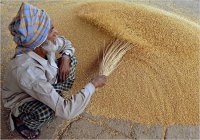
So this week, I blogged about two unfortunate murders in the community. Maybe as a release, maybe just to cheer everyone up for the weekend, I am returning to my Friday lite post.
We’ve seen the talent in Britain, with Suleman Mirza and Madhu Singh together as Signature. And as brilliant as they may be, I have a partiality towards Sardool Sikandar.
Sardool Sikandar is often known more for his marriage to the beautiful Amar Noorie than for his own singing talent. However, hits like Tor Punjaban Di and Mittran Nu Margiya still remain some of my favorites.
Here is a recording from the mid 1980s at Doordarshan’s Amritsar studios. It was this performance that launched the Sufiana classically-trained Sikandar’s career. Here he does various impressions of Mohammad Siddique and Ranjit Kaur’s classic “Aagay Roadways di lari, na koi sheesha na koi bari….”

While I am partial to his amazing Kuldip Manak and Yamla Jatt, do you have a favorite?
Adding onto prior posts concerned about the environment, it’s interesting that the Transport Minister of Punjab made a statement today by riding his bike to work.
In a rare display of a public official and a cabinet minister and that too the transport minister of a state at its austere best, Master Mohan Lal, Transport Minister of Punjab on Thursday chose a rather conventional mode of transportation to reach his office at Civil Secretariat, here… Master rode a bicycle from his official residence in Sector 39 to attend his office. [link]
His one day bicycle ride was in response to increasing oil prices. Like Earth Hour, statements such as these are beneficial, but ultimately ineffective unless backed up by real, sustained efforts to change peoples’ actions on a daily basis. So – great statement Mohan Lal ji, but is it just a show?
The police have apprehended two suspects and are charging them with the killing of Navtej Singh. The police are still searching for additional suspects and accomplices.
————————————————————
Many of our friends and family own small businesses. Whether gas stations or convenience stores, the hours are long and the risks are high. Few of us would probably not be aware of some friends or family that have not had some circumstance occur while working.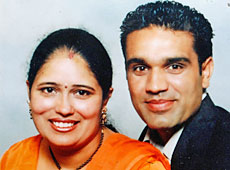
In Auckland, the New Zealand Sikh community suffered a tragedy with the killing of 30 year old, Navtej Singh, a father of three children all under 5 years of age.
Almost as disturbing as the cold-blooded murderers, who stole fifteen bottles of beer and a few dollars, was a callous customer that stole a box of alcopops as the victim lay in his blood.
The 12,000 member Sikh community in New Zealand is an established community with five gurdwaras and are asking questions. There is some division as to whether these crimes have a racial motivation or are crimes of opportunity:
“What is happening in South Auckland?” asked Sandeep Verma, who was with Navtej Singh when he was shot, and when he later died in hospital.
“All the people from the Indian community, whether they are Fiji Indians, Indians, Punjabis, Gujaratis; only those people are the main target.
“What are the police doing for the security of our people?” [link]
A recent play seems to have caught my attention. I provide the description here in length:
Dangalnama is a gripping account of sectarian rioting in India since the assassination of Indira Gandhi in 1984. It is also the story of a younger generation making sense of their history.
Through the voices and personal testimonies of Indian journalists, students, artists and politicians, director Prasad Vanarase presents survival stories, which shed light on the current social, economic and political climate in India today and the wide disparity between the poor-rural and modern-urban population. Performed in five languages (Hindi, Marathi, Gujarati, English and Kannada), this eye-opening and satirical take on Indian’s recent past also looks forward to a more unified future.
Dangalnama boasts a cast of 14 drawn from across India. Using satire and comedy, Dangalnama shows us the human side of India’s complex and often hidden issues in this powerful 90min production followed by a lively 30min discussion with the cast and director. [link]
Dangalnama A Flame Production directed by Prasad Vanarase
A Lift commission / UK Premiere
Fri 13 – Wed 18 June 13, 14, 15, 16, 17: 7.30pm – 9.30pm
15, 18: 2.00pm – 4.00pm
An immediate observation leaps out at me from the description. It is striking though that the play in being performed in five languages, yet the main language of the victims of the genocide, Punjabi, is left out. I wonder why?
In a day of updates, I figured I should update this one as well.
Although losing out on the 100,000 pound grand prize, the dynamic duo of Suleman Mirza and Madhu Singh have been invited by Michael Jackson to join him on his comeback tour in the UK. The newspaper report is a bit ambiguous suggesting that Signature may also perform with MJ in Las Vegas as well. Amazing job fellas! I am sure they are on cloud 9.
—————————————————————
We’ve been following Signature over the last few months. From their audition appearance, to their semi-final Thriller, to even an interview with me highlighting their place in British Bhangra, before we all suffer from Signature overkill here is Suleman Mirza (often misspelled as Suleiman ) and Madhu Singh’s final performance.
Our dynamic Muslim and Sikh duo finished second on Britain’s Got Talent (BGT) to the dancing talent of George Sampson. While I was hoping for a “Beat It” performance, Madhu’s busy work schedule at PC World may not have allowed him to come up with a new routine. They stuck to their bread and butter of Tigerstyle’s Nachna Onda Nahin. A fine performance fellas. You even got Simon Cowell and the rest of the dorky judges to dance in their chairs.

Since the Sikh community first learned about Navraj (Nuvraj) Singh Bassi, many on the internet have rushed to create facebook groups, orkut groups, and other fan displays. I think the CFL in general, but the SASKATCHEWAN ROUGHRIDERS, in particular, will see a new group of excited fans.
I think the CFL in general, but the SASKATCHEWAN ROUGHRIDERS, in particular, will see a new group of excited fans.
Many have wondered about Nuvraj Singh Bassi’s status and luckily here in The Langar Hall, we have made friends with some great Roughrider fans, including Behaving Bradley, photographer Downtown Aaron Brown, Giventofly (GTF), and others on the Roughrider Fan Forums.
So from what I gather, Navraj is still a ‘raw’ player, but many are excited about the player he may become. He seems to have suffered a foot injury, but is still in attendance at training camp. We hope him a speedy recovery and the Roughriders a great season! We’ll try to keep you updated with the help of Behaving Bradley and others from the forum!
——————————————
A long time ago, my fellow Langa(w)r-iter, posed the question:
Can a kesdari Sikh man excel at high levels of athletic competition in the U.S. and practice his faith? [link]
Back then she was introducing us to Darsh Singh, Trinity University’s keshadhari (turbaned) Sikh starter and co-captain.
Today, I introduce you to Navraj Singh Bassi.
In Ceres, California an 86 year old Sikh bibiji, Jagir Kaur Johal, was found stabbed to death in her home. The Modesto Bee reports: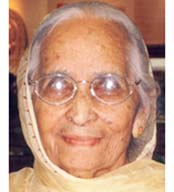
She died as a result of loss of blood from a stab wound to the chest and multiple slash wounds to the face, arms and legs, the Stanislaus County coroner’s office said.
Authorities said today the woman’s husband, 85-year-old Piara Johal, likely will be arrested.
Johal had a knife wound on his hand. The man was “suffering from some kind of confusion. He’s not sure what happened,” McKay said. “He acted as if he didn’t know of her injuries.”
“This is a hard case,” McKay said. “He’s old. He’s feeble. We don’t even know he if knows what he did — if he did it.” [link]
I had a long and interesting conversation with a friend of mine this weekend on different attitudes towards finance and charity between different world religions. We noted that both Judaism and Sikhi require a 10% charitable contribution, in addition to service, which has no upper or lower bound and serves a different purpose. This dovetailed with a conversation I had with a few friends, including one who is an Islamic banker in Dubai, about religious concepts of usury, interest, and charity.
For many low-income and poor communities, asset/wealth creation is a major hurdle, and access to financial/resource markets and services is non-existent. Although Sikhi has strong proscriptions against materialism, greed (moh), and attachment (maya), it also has a redistributive element. While simplicity is embraced, wealth is not necessarily wholly eschewed (if earned honestly and put to just uses).
If a financial institution were opened upon Sikh principles, what would it look like, to you? What kind of services would it offer, or how would it help address the structural exclusion of the poor? For example, I could imagine very low interest or no interest loans, but perhaps other infusions? In other time periods, Sikhs built free clinics and community schools. Khalsa College, on an endowment from one of its funders, still offers free college tuition to local residents (regardless of religion). What are the kinds of “assets,” beyond simply wealth, that could contribute to Sikh principles of economic justice? Do you feel such principles (i.e., economic justice) exist in Sikhi?
 About a week ago, Sex And The City (SATC) hit theaters. Many may resist an association with the dating scene that the movie and show explored with the lives of Punjabi Sikh women, and wonder whether this is appropriate for The Langar Hall. But the stories and characters of SATC reflect broad ideas that apply to all women and since every woman I know has seen or is planning to see the movie, I’m curious about how these themes apply to Punjabi Sikh women in particular and how our experiences compare with other groups. This post does not promote anything portrayed in SATC, but instead explores the stereotypes in the characters and questions how our Punjabi-Sikh-ness affects how much of those stereotypes we embrace. First, what is SATC really about?
About a week ago, Sex And The City (SATC) hit theaters. Many may resist an association with the dating scene that the movie and show explored with the lives of Punjabi Sikh women, and wonder whether this is appropriate for The Langar Hall. But the stories and characters of SATC reflect broad ideas that apply to all women and since every woman I know has seen or is planning to see the movie, I’m curious about how these themes apply to Punjabi Sikh women in particular and how our experiences compare with other groups. This post does not promote anything portrayed in SATC, but instead explores the stereotypes in the characters and questions how our Punjabi-Sikh-ness affects how much of those stereotypes we embrace. First, what is SATC really about?
the three-girls-in-the-city movie… a cinematic staple since the 1920s, has been an unusually enduring and lucrative one, exploiting each succeeding era’s anxieties surrounding women’s changing roles and helping define those eras’ new ideas of modern life. In them, audiences can watch women negotiate and sometimes subvert the forces that limn and limit their choices. [link]
Prices go up after Monday. Take a moment at work, take a quick break from your finals, but take it now! A commenter asked to for a meet-up at the conference. A few of the bloggers will be in attendance so come meet a few of the faces behind the nonsense we write! Register now at www.jakara.org
———————————————————————————
From our discussions on dividing Gurdwaras to Green Gurdwaras; from confronting the demons within to forging a new consensus; from questions of grassroots movements to moving beyond generation two blues; all are invited to attend JAKARA 2008 and discuss face-to-face these important issues.
 The Jakara Movement Sikh youth conference is only three weeks away with registration closing on June 16th. REGISTER NOW to avoid late fees.
The Jakara Movement Sikh youth conference is only three weeks away with registration closing on June 16th. REGISTER NOW to avoid late fees.
Who: YOU!
What: JAKARA 2008: Growing with our Gurdwara
Where: FRESNO, CA
When: June 19-22, 2008
Why: Because YOU need to be there. Visit the website for more information.
Yes I had urged all to attend in a different post, but consider this a friendly reminder.
Plan to attend, even if you just want to see life beyond bhangra or shoooooooooot, because you just want another Sikh T-shirt (no, you don’t get those ones).
WARNING: This is MY opinion and DOES NOT not represent anyone else on The Langar Hall. Hopefully, unlike Ennis, I won’t have to take this one down.
I am sure I am going to be labeled as a hater. I don’t care it must be said.
Scouring the news I came across a recent press release by the Sikh Council on Religion and Education. I almost feel even more embarrassed by highlighting it. SCORE, for the uninitiated, is a Sikh organization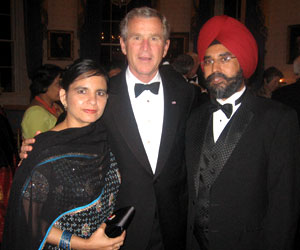 based out of Washington DC. It is the child of Dr. Rajwant Singh, a Maryland-based dentist. He is definitely one of those guys that likes to ‘speak for Sikhs.’
based out of Washington DC. It is the child of Dr. Rajwant Singh, a Maryland-based dentist. He is definitely one of those guys that likes to ‘speak for Sikhs.’
Like many Sikh organizations, SCORE is a one-man show. Don’t believe me, check out the pictures on the website, you’ll find few without Dr. Rajwant Singh. He may be the most pictured Sikh-American. (Look to the right, I just added one more!)
Now I really don’t know what SCORE does, other than look for photo opportunities, but to Dr. Rajwant Singh’s credit, he has established relationships with many political figures in Washington DC and has ingratiated himself as the ‘Sikh’ representative in many interfaith functions and communities in DC. DC loves interfaith functions! That is a good thing. Sikhs should have a representative and in the meantime we have Dr. Rajwant Singh.
In certain cultures, memorization has always been a means of oral transference of knowledge through the generations. My father can quote so much random poetry. I see others that can quote entire passages from Waris Shah’s Heer. Although some of us still take the time to memorize Sikh prayers and gurbani, I wonder how much oral knowledge is about to be lost in our generation?
Here is a look at one government school in Punjab. Interesting how nursery rhymes there are sung in a manner different than elementary schools here. Does anyone else notice the subtle differences in promoting a ‘rote’ model? Well, even if you don’t and I am just seeing something that isn’t there, enjoy the video and enjoy your weekend!

Guest blogged by Mewa Singh
Yesterday’s post by Sundari got me thinking. When I saw the videos of the from the BBC footage from those days in 1984, I began wondering can the Sikh community mobilize like that again? Under what circumstances could it or even should it mass mobilize?
I thought of the mobilization that occurred with the Ram Rahim incident last year. Then while reading the internet news, I came across this Bay Area video.
CLICK HERE TO WATCH VIDEO (sorry the website doesn’t allow me to embed the video)
The media was given the title as the “Spiritual March for World Peace.” Although I have been out of the loop with friends for sometime with my Bay Area friends, what was the ‘real’ reason for the gathering? Was it celebrating the shaheedi of Guru Arjan? Do we really have Nagar Kirtans to remember martyrdoms in our history? Should the march be construed as an anti-war protest? Partially to raise awareness, but partially to learn about the initiative as well, I would love to hear about the background, perspectives, or even your thoughts on this Nagar Kirtan.
Through various posts on this blog, we have discussed the idea of activism (and even lacktivism) within the Sikh community. Recently I have been thinking about what activism meant to our parents’ and grandparents’ generation and in what form they expressed their personal and political thoughts. Twenty four years later, as we remember the events of 1984, we are reminded of how much these events raised Sikh consciousness. It is also a historic event in another sense. The response to the events of 1984 allowed for our parents and grandparents to stand in solidarity with other Sikhs and in doing so, mark their place in Sikh history on both a personal and political sense.
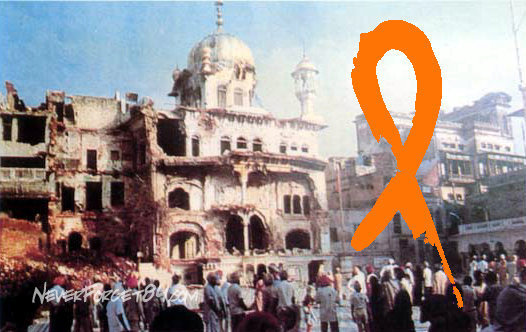 During those days and weeks following the invasion of the Darbar Sahib, hundreds and thousands of Sikhs took part in protests. I remember hearing about these stories from my Dad who ardently took part in these protests in London and Liverpool. However, what was more striking to me, was the role my Mum Mom played in these protests. I remember visiting a museum whilst on a school trip (a few years after 1984) and seeing pictures of the protests on display. I was caught off-guard as I saw a picture of my mother with her fist in the air protesting alongside other Sikh men and women. That image has stayed with me – essentially the activism that has always existed and remains to exist within our community. I wasn’t able to find much press about these protests, but did come across this clip.
During those days and weeks following the invasion of the Darbar Sahib, hundreds and thousands of Sikhs took part in protests. I remember hearing about these stories from my Dad who ardently took part in these protests in London and Liverpool. However, what was more striking to me, was the role my Mum Mom played in these protests. I remember visiting a museum whilst on a school trip (a few years after 1984) and seeing pictures of the protests on display. I was caught off-guard as I saw a picture of my mother with her fist in the air protesting alongside other Sikh men and women. That image has stayed with me – essentially the activism that has always existed and remains to exist within our community. I wasn’t able to find much press about these protests, but did come across this clip.
Please share your thoughts/memories.
A couple of weeks ago while driving with my friend Rajpreet, I started speaking Punjabi in the middle of an English conversation. I was caught off-guard by Rajpreet’s response, “… why are we speaking the ‘secret language’ when it’s just us two in the car”? Rajpreet for some reason thought we only spoke Punjabi amongst ourselves around other English speakers when we had something “secret” to say [in the past we also spoke it when there was another Punjabi-dominant speaker with us]. However, for myself, it just happened, after some thought I feel I spoke out of the comfort of knowing that Rajpreet also understood Punjabi … not to say anything “secret”. Rajpreet’s statement made me think about how at department stores and other official places of business, I sometimes spoke a mixture of Punjabi/English to family and friends because we did not want other English speakers to know what we were saying in “translation” … but it was not always the case. Sometimes it was out of comfort, group/ethnic solidarity, or just plain funny. In my eyes, I wasn’t using Punjabi as a “secret language”, but more as a form of code-switching or hybrid language use.
Code-switching is a sociolinguistic phenomenon where bilingual speakers (i.e. Spanish/English and Punjabi/English) use terms from both languages in a sentence or conversation. In the past researchers have argued that code-switching was a sign of language inability. For example, the speaker did not know the terms for bowl or potato in English so used the Spanish or Punjabi terms. However, now sociolinguistic researchers believe it is a marker of group identity, ethnic solidarity, and relationship-building. I remember one person telling me that as part of his research on hybrid language use at a major state-owned park, he found that one park employee spoke “Spanglish” to their largely Latino cliental because she wanted to convey safety, comfort, and other feelings of “home” at this large American “place”. By creating such an environment through language she felt that the Latino cliental was more likely to explore the site and ask questions.
Thus, I ask do you ever speak Punjabi to English-speaking friends and family? If so, when?
Do you code-switch? Why?
While exploring the Sikh blogistan, I came across this link from Sikhswim (Thanks Savraj!) and wanted to share it with the rest of the Langar-ites.
Late last year, November 2007, a Sikh Seattle taxi-driver, Sukhvir Singh was brutally attacked by a drunken Luis Vazquez. Luis had been placed in Sukhvir’s taxi by two police officers, after he had been denied entry into Husky Stadium for public drunkenness and alcohol-induced bellicose behavior.
The story may have ended with the sentencing of Luis Vazquez, but it doesn’t. The story is also about the Sukhvir’s courage, faith, and forgiveness. Sukhvir was the vehicle for Waheguru’s forgiveness. Luis has been given another opportunity. The video is a bit extended, but well worth the watch.
Reflection for Monday by Guru Nanak from SGGS (p. 223) in Raag Gauri:
Khima Gahi Brath Seel Santokh
Extending forgiveness is the (true) fast, (the true act of) kindness, (the true path of) contentment
So we have seen two (here and here) performances by Signature. Although most Langar-ites did not seem to enjoy the second performance as much, it impressed enough people to propel the duo into the finals of Britain’s Got Talent. In fact they were the first team to be voted in by the public.
Now, in their first interview, Suleman (often incorrectly spelled Suleiman ) Mirza and Madhu Singh shed some light and perspective on their performance:
“Our routine is about togetherness and overcoming conflict,” said the rather handsome Mirza, who has been a Jackson fan since he was six years old. “I start the act with a Western dance, and then Madhu comes on stage. I look down on him because I don’t understand his culture. But he surprises me, and he works really hard, symbolising immigration, and then we work together, and show that everyone can get on.”[link]
Heavy stuff, but I’ll buy it.
Sharon Stone’s recent comments about whether or not the earthquake in China was due to bad karma over Beijing’s occupation of Tibet has caused quite a stir. Stone is now facing a backlash in China with her films being boycotted (Um, what films?) and luxury retailer Christian Dior pulling advertisements featuring Sharon Stone from stores. The Chinese earthquake killed at least 68,000 people. China has been under much scrutiny in recent months over Beijing’s policies in Tibet. “I thought, is that karma – when you’re not nice that the bad things happen to you?” she mused at the Cannes Film Festival. However, many people feel that Stone’s contextual use of Karma is simplistic and in fact, inaccurate (the actress later apologized for her remarks).
Karma is an important concept for Buddhists, Hindus and Sikhs. Translated from the Sanskrit, it means simply “action”. Because karma is used in a number of ways and contexts this can be confusing…Stone’s take on karma is common – glossed over as an outcome that is the result of something done in the past – or even a past life. But the law of karma states that it’s the motive behind one’s actions that affects the outcome of that particular act. “The earthquake in China or the cyclone in Burma have much to do with environmental factors,” says Dhammadassin. “To invoke karma is more to do with our desire to nail things down and find someone to blame. But that’s not ours to do.” [Link]
So, it got me to thinking about what Sikhi says about Karma. Sikhs use the term generously (and sometimes, not so generously) but perhaps we don’t have a solid understanding of what it really means. The doctrine of karma, according to Sikh belief, is a part of the Divine law (hukam). “The whole universe,” says Guru Arjan, Nanak V, “is bound by action, good or bad” (GG, 51). Guru Nanak declares in the Japji that “all forms, beings, greatness and lowliness, pain and pleasure, bounties and wanderings are subject to the indescribable hukam and there is nothing outside the realm of hukam,” (GG, 1) and then adds that “karma determines the kapra, i.e. body or birth we receive and that it is through nadar (God’s grace) that one secures the threshold of moksa” (GG, 2). [Link]
Do you believe in Karma?
The Punjab government has finally allocated funds to assess the breadth of farmer suicides in the state.
The Punjab Government seems to have finally woken up to the need of having a census on farmers’ suicides in the state. The state government, it is learnt, has the [sic] entrusted the arduous task of completing the census to the Punjab Agricultural University. As per Dr R.S. Sidhu, head of the Department of Economics, PAU, “The state government has asked us to do the work and we have taken it up as a research project. Though whole of Punjab is to be covered under the study, the state government has asked us to do a pilot project in two districts of Punjab, Gurdaspur and Sangrur initially.
The census will be conducted by the Punjab Agricultural University (PAU), based in Patiala Ludhiana. During the first phase of the survey, PAU will conduct a door to door survey in about 1,500 villages in Gurdaspur and about 575 villages in Sangrur out of the 12,000 villages in Punjab. The report from this initial phase is set to be completed in four months from the beginning of the survey, which is set to begin in the next couple of weeks.
The census will take into account farmer suicides occurring after April 1, 2005, excluding suicides of farm laborers.
Rising pesticide and fertiliser costs, shrinking land holdings, declining soil fertility and heavily-subsidized farming in wealthier countries are some of the factors blamed for these suicides.
In recent months I have witnessed the ceremonial openings of three new Gurdwaras in the Central Valley area. The number of new Gurdwaras are continually growing. Some people may applaud this action as an indicator of our success for having the ability to build million dollar Gurdwaras. But is this the right direction for our community to be heading?
By building more Gurdwaras, we are dispersing as a community rather than emerging as one. Growing up in the UK, all the people we knew growing up attended the one Gurdwara in our town. After some time, the space capacity was too constrained and people began complaining about not being able to sit with the Sangat. Since there was no additional space around this Gurdwara, there wasn’t any expansion work that could be performed. As a consequence, another group opened a new Gurdwara in the same town which fufilled the capacity issues, since it was almost three times larger. So slowly the Sangat at the smaller Gurdwara began to dwindle due to more and more people attending the larger Gurdwara.
Why wasn’t it possible for the community to come together and move as a “whole” to the larger Gurdwara? In the Central Valley there are so many choices of Gurdwaras to attend, but I personally feel this is dividing us. Politics and ego are at play when these associations and groups get together to begin implementing a “bigger, better, more expensive” Gurdwara.
Have any of you witnessed similar divisions happening within your communities and Gurdwaras in your area? Do any of you think this is a positive progression? Is there anything we can do as a younger generation to unite the community?
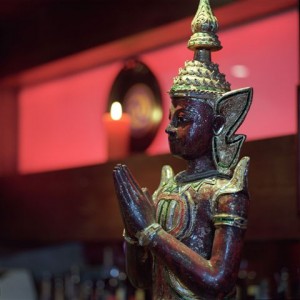 Karma is an important concept for Buddhists, Hindus and Sikhs. Translated from the Sanskrit, it means simply “action”. Because karma is used in a number of ways and contexts this can be confusing…Stone’s take on karma is common – glossed over as an outcome that is the result of something done in the past – or even a past life. But the law of karma states that it’s the motive behind one’s actions that affects the outcome of that particular act. “The earthquake in China or the cyclone in Burma have much to do with environmental factors,” says Dhammadassin. “To invoke karma is more to do with our desire to nail things down and find someone to blame. But that’s not ours to do.” [
Karma is an important concept for Buddhists, Hindus and Sikhs. Translated from the Sanskrit, it means simply “action”. Because karma is used in a number of ways and contexts this can be confusing…Stone’s take on karma is common – glossed over as an outcome that is the result of something done in the past – or even a past life. But the law of karma states that it’s the motive behind one’s actions that affects the outcome of that particular act. “The earthquake in China or the cyclone in Burma have much to do with environmental factors,” says Dhammadassin. “To invoke karma is more to do with our desire to nail things down and find someone to blame. But that’s not ours to do.” [